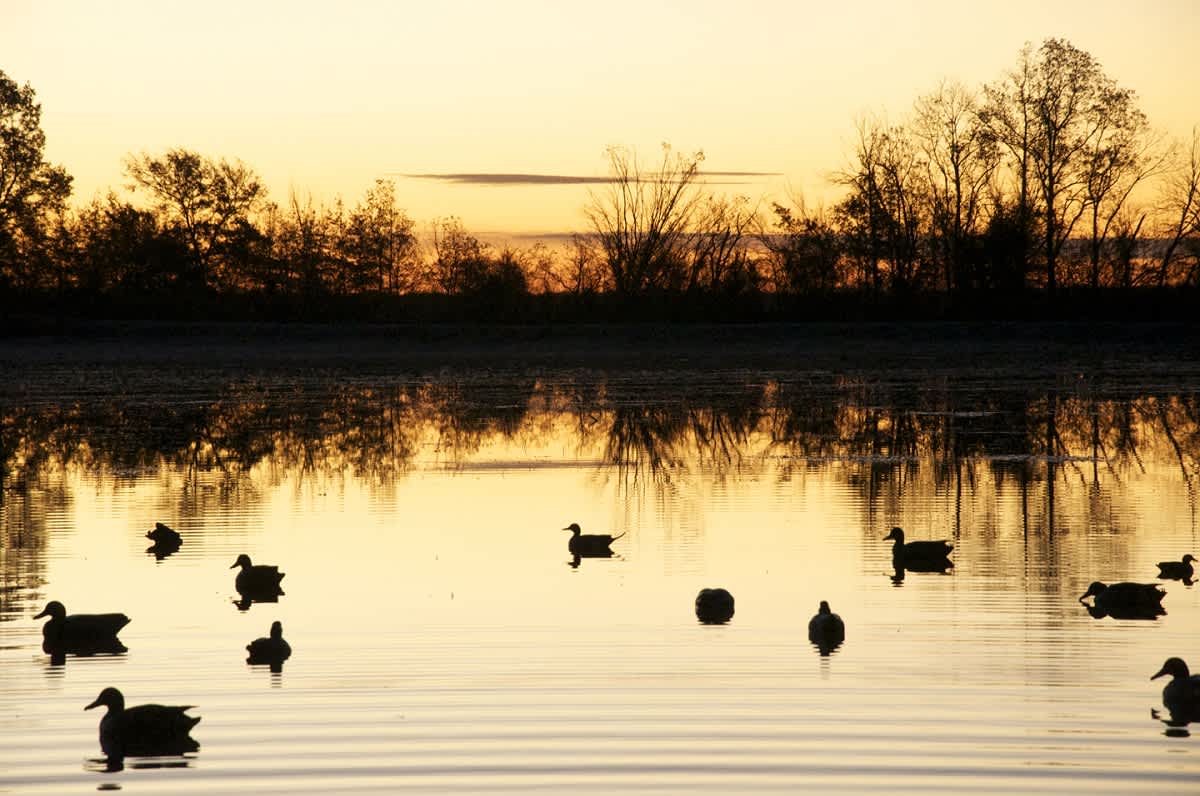Slowly Moving South: The Migration
Josh Wolfe 12.11.14

The migration, much like the rut down South, seemed to be on its way—until it wasn’t. On a calm and rather warm morning two days before Thanksgiving, sitting in a blind overlooking a rice field near Augusta, Arkansas, Lyle, my father, Chad Powell, and myself waited for a little more light at 6:19 a.m. I was silently happy we’d missed the 20-degree temperatures that had hung around the week before.
Standing there in the Bridge Blind, watching for the coming sun, teal choreographically buzzed by, never a falter or a wrong turn by a single bird. During aforementioned cold snap, as we’d heard from other members of the club and photos indicated, the mallards had been in the area. So, as usual, I sat content that I was hunting rather than working, and set no expectations for the morning.
By 9:00, we had three limits—mainly teal, a couple greenheads, some gadwalls and shovelers, and one bull pintail. While the migration wasn’t concentrated in the area, there were ducks around. Perhaps it was the tail end of what had flown down the week before.
Over the years, I’ve asked various biologists about the migration and the patterns of ducks. Some have told me flyways are arbitrary, saying ducks are unlike deer in that they don’t necessarily follow the same paths consistently. Others have argued the point, and rightfully so, that the migration isn’t just one direction. Southbound ducks will turn back north, and vice versa if the weather and other factors persuade them to do so.
As many waterfowlers do, I rely on Ducks Unlimited for the majority of my migration information. If you want to save yourself 10 hours of needless driving, DU’s online Migration Map is a good point of reference. For us, that Monday afternoon before Thanksgiving, reports were reasonable enough to permit me to take the rest of the week off work.
Lyle was there, as usual, having mostly recovered from the chipped tooth that kept him out of South Dakota. And his Lab, Bella, accompanied us as well. Much like her first time on the Midwest prairies chasing pheasants, she faired equally well in the Arkansas Delta. She’s driven, and somewhat overly anxious at times, but did she ever save us from walking our legs off!
We’d given up on a hen shoveler that took a final plunge down into the rice field some 400 yards away. Twice Lyle and I searched the area before giving up. Instead of trudging all the way back through the Arkansas mud to the blind where the other two were picking up decoys and preparing to leave, we opted for the nearby levee that would take us on an easy stroll to the ATVs. Perhaps Bella sensed our willingness to take the easy way out and went on ahead through the thin row of trees toward the bank. Except she didn’t make it quite that far. Some distinct smell caught her nose and she whipped right and scooped that hen shoveler up in her mouth in one smooth motion. Lyle said my jaw nearly hit the water as she came trotting up, head and tail held high, with the duck in her mouth. Dogs know when they’ve done well. And because of one good yellow Lab, we didn’t lose a single duck that morning.
After cleaning the ducks, we skittered down to nearby McCrory for a shrimp po’boy followed by a nap. That evening we watched the influx of geese arriving in the area and that night at dinner we ate like kings—boudin sausage not long out of southern Louisiana, grilled teal wrapped in bacon, and pan-seared duck breast in a bourbon sauce served over rice with biscuits.
The next and final morning was a bit slower—two teal, one gadwall, and a ringneck. But there was something else special about that hunt. Chad’s six-year-old son, Sawyer, sat in the blind with us. It was his first duck hunt, and while he didn’t shoot, he constantly asked questions, ate honey buns and wondered aloud why Bella whines so much, all the while actively seeking the answers to the finer points of the sport of duck hunting.
“Dad, why does your calling sound like a yelping puppy?” Chad’s a fine caller.
“Why aren’t the ducks falling when you guys are shooting?” He had us there.
When we decided the ducks had moved on, Sawyer was out there in the decoys with us—all three feet of him. The water was fairly shallow and he wanted to get his waders wet, though he stuck his hand in the water one time before he was ready to be escorted to shore. It was a quick trip, but hopefully just a warm-up for the months to come when we drop everything we’re doing to the cheerful cry, “The ducks are coming, the ducks are coming!”
Check out DU’s website, where you’ll find the Waterfowl Migration Map, reports and the opportunity to subscribe for migration email alerts.

